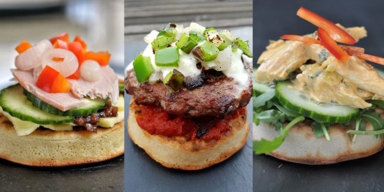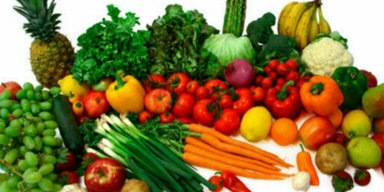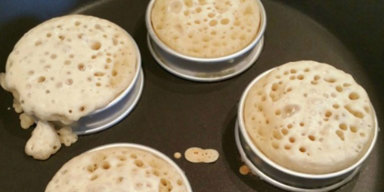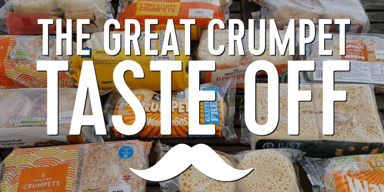Making your own
Crumpets are easy to make. Candidly, it's easier to open a packet of Warburtons, but making your own is a bit of fun, and crumpets are particularly lovely fresh and hot from the pan.

Be warned that they take a while to cook - and mustn't be rushed - so don't start the process starving hungry.
Preamble: Of all the recipes in all the world
There are numerous recipes for crumpets on the online. Without wishing to bore people with detail, here are some of the options.
Ingredients
Flour: at one extreme, you have 100% “strong” bread flour, at the other, 100% plain flour. Bread flour helps to create more rise from the yeast but can be a bit chewy - so most recipes (including ours) have a mix of the two.
Milk vs Water: Again there are two extremes: 100% water going to 100% milk. Milk provides additional depth of flavour, but we find that too much makes the batter heavy, and therefore use a higher weighting of water than milk.
Consistency: the variations are all on a theme of around 150ml (5.3 floz) of liquid to 100g (3.5 oz) of flour.
Raising agents: some recipes blaze a trail with yeast alone. This won't make for a successful crumpet.
Preparing the batter
Yeast: several recipes don't bother, but we've found that mixing the dried yeast with liquid before adding to the flour helps with the raising process.
Salt: salt has a retarding effect on the activity of the yeast, so it's better to add this after the first raising process (see below).
Liquids: while it takes a little longer, adding some of the liquid at the end of the process produces a more liquid batter, which makes cooking easier.
Bicarbonate of soda: several recipes allow a few minutes for further proofing after the addition of the bicarbonate of soda. We've found that while this makes the final mixture look more bubbly, the crumpets actually come out less bubbly - presumably because the effect of the soda reduces over time.
Cooking the crumpets
Oil: while the crumpet rings need to be greased with butter, the pan itself really doesn't need anything else - the batter doesn't stick to the pan. If you have a particularly ineffective non-stick pan, just add a little butter - it won't burn if you're cooking on a low heat. The point is, ignore those who suggest oil for cooking.
The main event:
Probably the best crumpet recipe in the world
Measurements in any baking seem to be based on the number of 7 g dried yeast sachets that are required. This makes about 20 crumpets.

| Preparation: 1 hour 40 minutes | Serves: 20 crumpets |
| Cooking: 40 minutes | Make your own |
| Ingredients | Quantity (metric) | Quantity (imperial) |
|---|---|---|
| Plain flour | 225 g | 8 oz |
| Strong white bread flour | 275 g | 9 oz |
| Dried yeast | 7 g | 0.25 oz |
| Bicarbonate of soda | 0.5 tsp | 0.5 tsp |
| Cream of tartar | 0.5 tsp | 0.5 tsp |
| Water - lukewarm | 500 ml | 17.5 floz |
| Milk - lukewarm | 150 ml | 3.5 floz |
| Salt | 1.5 tsp | 1.5 tsp |
| Sugar | 0.5 tsp | 0.5 tsp |
METHOD
- Mix the yeast, sugar and 100 ml (3.5 floz) of the water in a large jug or bowl. Let it stand for 10 minutes, until it’s foamy, then add the remaining water.
- Mix the flour and cream of tartar in a large bowl. Add the yeast mixture gradually to the flour, mixing well. Beat vigorously for 2 minutes until the batter is thick but smooth.
- Cover with clingfilm and leave in a warm spot for about an hour, during which time the batter should rise, then start to fall again. If it hasn’t done this, your spot is probably not warm enough.
- Add the salt and beat for another minute. Re-cover and put the bowl back in its warm spot for another 20 minutes.
- Dissolve the bicarbonate of soda in the milk, then stir into the batter, which by now should look like this:
- Smear the insides of the rings with butter before you start cooking.
- Put a large frying pan on a low (not very low) heat. You don’t need oil – the crumpet mixture won’t stick to a non-stick pan.
- Ladle the batter into the rings, leaving about a quarter of the ring visible at the top (leaving the crumpets with room to rise).
- Cook until the tops of the crumpets are solid and the bubbles have stopped bursting – which takes a good 10-15 minutes. This can seem like an eternity
but don’t turn up the heat – you’ll end up with a solid top but a soggy middle.
- Take the crumpets out of the pan and encourage them out of their rings. The rings are obviously hot, so use oven gloves. The crumpets should just fall
out, but use a knife if you have any sticking issues.
- Put the crumpets back in the pan, hole side down, and cook for about 3 minutes.
- That batch is ready and will happily sit in the oven at 100 degrees centigrade while you move onto the next one.
- If you’ve had any sticking issues, wash the rings – otherwise just start again at 1.
Preparing the batter

Adding flavours
It's really easy to create some culinary excitement by adding flavours to your batter before cooking. Because you add the flavours right at the end, you can create small portions of each.
Here are some ideas: Making your own: adding flavours
Cooking the crumpets
You’ll need rings in which to cook the crumpets - and it’s really important that they are non-stick. If the mixture starts sticking to the rings, it’s
a total pain to get them out, and it makes them look a mess.
Making shapes!
You can make crumpets in any shape for which you can find a mould - and this can add a lot of fun to the whole exercise.
Here are some ideas: Making your own: making shapes!









